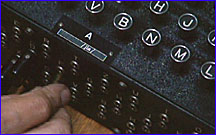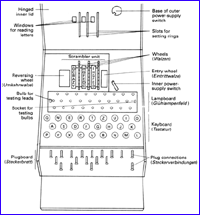
|
 |
 |
 How the Enigma Works
How the Enigma Worksby Alan Stripp The Enigma machine, first patented in 1919, was after various improvements adopted by the German Navy in 1926, the Army in 1928, and the Air Force in 1935. It was also used by the Abwehr, the Sicherheitsdienst, the railways, and other government departments. From then until 1939, and indeed throughout the war, successive refinements were introduced, varying from service to service, and there were detailed changes in operating procedure until 1945. The following short description can therefore summarize only its main features and mention only a few of the Enigma variations. The Enigma (see diagram below) was used solely to encipher and decipher messages. In its standard form it could not type a message out, let alone transmit or receive it. From the cipher operator's point of view, it consisted of first a keyboard of 26 letters in the pattern of the normal German typewriter:
Q W E R T Z U I O
A S D F G H J K
P Y X C V B N M Lwith no keys for numerals or punctuation. Behind this keyboard was a "lampboard" of 26 small circular windows, each bearing a letter in the same QWERTZU pattern, which could light up, one at a time, from bulbs underneath. (The model with an A-Z keyboard, shown in several books on the Enigma, is a Polish-French replica, not an actual Enigma machine.) It measured about 13.5" x 11" x 6", and weighed about 26 lbs.
The three central wheels were selected from a box of five. Monthly orders specified a new choice every day, as well as their relative order in the machine, e.g., V-I-III or II-IV-I, etc. Each of these rotating wheels has a circle of 26 spring-loaded terminals on its right side and 26 flat circular terminals on its left, so as to provide an ever-changing series of connections as it revolves. Each contains a different internal wiring and carries the letters A-Z or the numbers 01-26 round its inner ring, which can be turned and locked in any setting before the wheels specified for a given day are inserted into the machine in the prescribed order, though they can still be turned bodily through slits in the inner lid, and the letters A-Z can be read one at a time in the window beside each slit. The specified setting of ring against wheel was called the Ringstellung. Each time a letter key is pressed, the right wheel moves on one of its 26 places. Once during every 26 moves, at the "turnover position" on the right wheel, the middle wheel will also move on one place; and when the middle wheel reaches its own turnover position it moves on again when the next letter is keyed, together with the left wheel.  Finally, the vertical front of the Enigmas used by the Armed
Services contained a "plugboard" with 26 pairs of sockets,
again in the QWERTZU pattern. These could be connected by
twin-cable leads—for example, coupling C to P, M to Z, J
to S, and so on; but some sockets, usually six, were left
unconnected. They were said to be "self-steckered."
Stecker is a plug; Steckerbrett (usually called
"steckerboard" at Bletchley) is a plugboard.
Finally, the vertical front of the Enigmas used by the Armed
Services contained a "plugboard" with 26 pairs of sockets,
again in the QWERTZU pattern. These could be connected by
twin-cable leads—for example, coupling C to P, M to Z, J
to S, and so on; but some sockets, usually six, were left
unconnected. They were said to be "self-steckered."
Stecker is a plug; Steckerbrett (usually called
"steckerboard" at Bletchley) is a plugboard.Each time the cipher clerk keyed a letter, the right wheel moved on mechanically one place and, as explained above, from time to time the center and left wheels also moved. As each new letter (e.g., P) was keyed, the current, normally provided by an internal 4.5 volt battery—although an outside power source could be used—flowed from a terminal under that key to a socket (e.g., P) on the plugboard. From there it travelled via a lead to another socket (e.g., L), or, if the first socket was self-steckered, it stayed as P. Either way, it ran to the entry wheel, which did not alter it, through the pairs of terminals on all central wheels—each of which normally altered it again—to the Umkehrwalze or reversing wheel (with another alteration) and back through different circuits in all three wheels (hence still further alterations), out unaltered through the entry wheel, and back to the plugboard. Here its course again depended on whether that socket was self-steckered or cross-steckered; either way, it finally reached the lampboard and lit a bulb (e.g., W). Although the process, involving up to nine changes on the standard three-wheel machine, has taken some time to describe, it naturally took place virtually instantaneously. And it must be remembered that the moving on of at least one wheel, for every new letter keyed, introduced a new set of circuits for each new letter. It is important to note that, if you press any key (e.g., B), any other letter may light up (e.g., T); but if you continue to key letter B, the lampboard may give, say, P, F, O, J, C..., but never B. The sequence will repeat only after 16,900 (26 x 25 x 26) keyings, when the inner mechanism returns to the same position. Messages were limited to a maximum of 250 letters to avoid this recurrence, which might have otherwise helped us. Continue: Basic set-up and possible keys Crack the Ciphers | Send a Coded Message | A Simple Cipher Are Web Transactions Safe? | Mind of a Codebreaker | How the Enigma Works Resources | Teacher's Guide | Transcript | Site Map | Decoding Nazi Secrets Home Editor's Picks | Previous Sites | Join Us/E-mail | TV/Web Schedule About NOVA | Teachers | Site Map | Shop | Jobs | Search | To print PBS Online | NOVA Online | WGBH © | Updated November 2000 |
